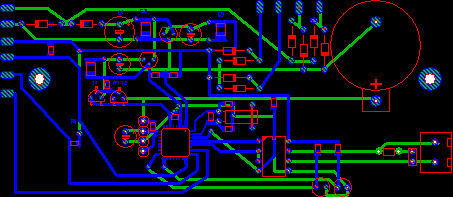There is no difference between drawing a macro
and drawing any other layout. Use the copper
layer (C1,C2) for pads and tracks and the silk screen layer (S1, S2) for
component outlines. Outlines are simply drawn
with ordinary layout elements (circles, tracks,
etc.) on the silk screen layer.
Please take care that your component is lying
on the board-side 1, when creating a
macro.
This means layers should be used as follows for
macros: The silk-screen-layer
should always be S1 (component is lying on board-side 1). Then the copper-layer
should be C1 for SMD-components or C2 for
"normal" components.
Example:
Let´s say you want to create a simple macro for a
DIL 14-pin-IC.
(This is only an example. Of course, a 14-pin DIL-IC is already included in the macro-library.)
1. Draw the Macro
Place the 14 pads on the layer C2 (copper-bottom) in the right grid distance. You may create a square-pad for the pin1, to identify this pas as "Pin 1".
(This is only an example. Of course, a 14-pin DIL-IC is already included in the macro-library.)
1. Draw the Macro
Place the 14 pads on the layer C2 (copper-bottom) in the right grid distance. You may create a square-pad for the pin1, to identify this pas as "Pin 1".
The component outline should be lying on the
board-side 1 (S1). This means that the pads,
which are on the other board-side, must be placed on layer C2.
Select C2 as the active layer and add 14 pads in
the correct arangement.
Change the active layer to S1 and draw a
rectangle around the pads, using the normal track-function.
Mark the "nose" or the pin 1 of the IC to define
the orientation.
 |
| That's it, your macro is ready. You will now have to save it and add it to the macro-library. |
 |
| Change to the edit-mode and select the elements by drawing a frame around all elements. |
 |
| All elements are now selected. |
3. Save the Macro
The function SAVE AS MACRO from the
FILE menu saves the current layout (or the current selection) to a macro file to disk. You can also click the
correspondig button in the macro-library. The
following dialog allows you to enter a filename for the macro, and to select the directory, where the macro will be saved.
The default extension *.LMK (which is the default suffix for all macros) for macros is added
automatically.
You may save the whole layout or parts of it as a
macro. If parts of the current layout are
selected, only the selected parts are saved to the macro file. If nothing is
selected the whole layout is saved as a macro
(after confirmation).

No comments:
Post a Comment